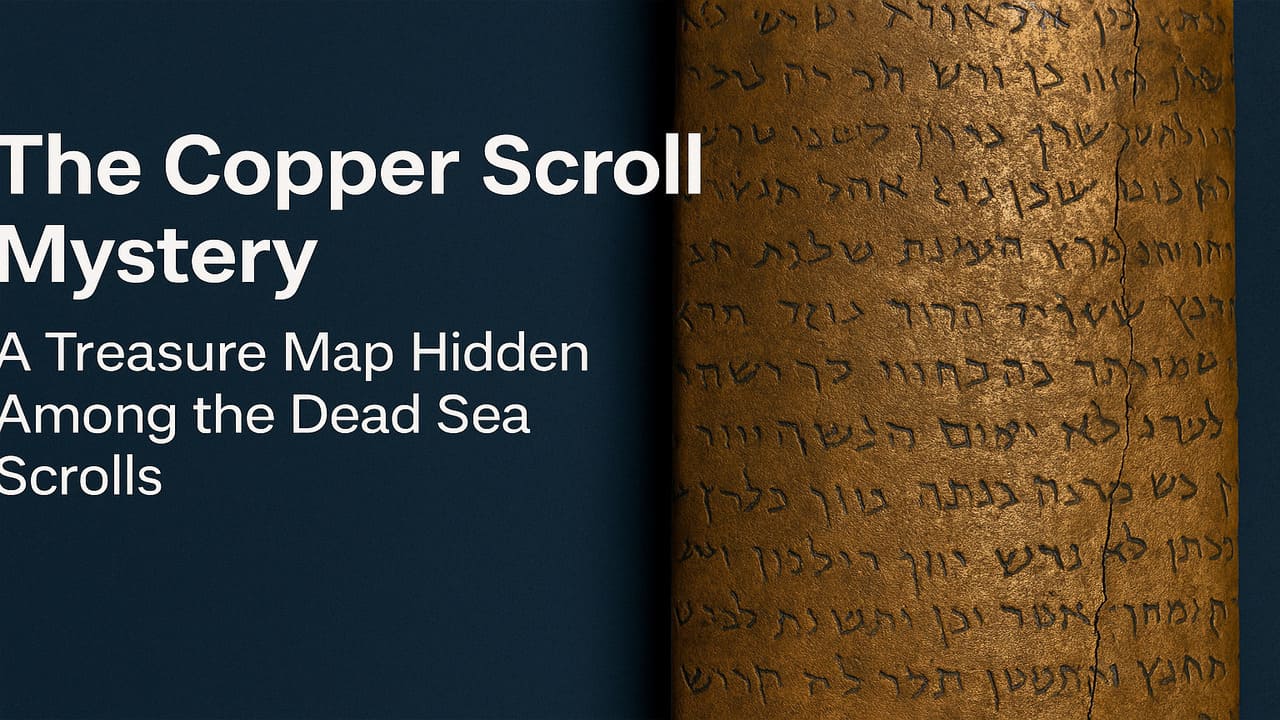
Thorn Ville Church – Discovered in Cave 3 in 1952, the Copper Scroll immediately drew attention. Unlike the other scrolls written on parchment or papyrus, this one was engraved on two thin sheets of rolled copper. It had to be carefully cut open along its seams to be read. And once deciphered, it revealed something astonishing a list of hidden treasures, specifying over 60 locations where vast quantities of gold, silver, and sacred items were supposedly buried.
No other Dead Sea Scroll reads quite like it. Rather than hymns, laws, or commentary, the Copper Scroll contains purely logistical instructions. It describes precise weights of precious metals and burial locations with cryptic references to geographical markers “in the ruin that is in the valley of Achor,” or “beneath the third step at the cave of the old washer’s house.” The total amount of treasure listed is staggering over 60 tons of gold and silver by modern estimates.
Scholars quickly realized that this scroll had no precedent in biblical literature. It wasn’t spiritual or symbolic. It read like a treasure map albeit one written in ancient Hebrew and using regional markers long since lost to time. The Copper Scroll’s unique language and tone led some to believe it came from a different hand. Possibly composed later than the other scrolls.
The purpose of the treasure remains unclear. Was it meant to fund a future temple? Was it an emergency reserve from the Second Temple period, hidden before the Roman siege? Or was it perhaps not real at all a symbolic inventory meant to inspire or warn?
Regardless of its origin, no documented treasure has ever been found matching the descriptions in the scroll. Countless expeditions, both professional and amateur, have combed the Judean Desert in search of the lost caches. The idea of sacred treasure hidden beneath ancient ruins continues to spark the imagination of treasure hunters, biblical scholars, and conspiracy theorists alike.
Also Read : Farm Worker Dies After Immigration Raid on California Farm
What makes the Copper Scroll so compelling in the field of biblical archaeology is how it blurs the line between textual discovery and physical exploration. Most ancient manuscripts offer spiritual insights, historical context, or theological reflections. The Copper Scroll, on the other hand, demands a shovel and a map.
It gives archaeologists rare, direct instructions leading some to regard it as a call to action. Could the hidden treasures be buried in still-unexcavated ruins in Jerusalem, Qumran, or Jericho? Could some of them lie beneath the waters of the Dead Sea itself, now risen since the scroll’s composition?
Several of the locations mentioned are frustratingly vague or symbolic. For instance, references to “the conduit in the Pool of Solomon” or “under the steps of the high priest’s tomb” may have carried meaning at the time of writing, but today, such clues often raise more questions than they answer.
The Copper Scroll’s influence has reached beyond academic circles. It has inspired novels, documentaries, video games, and film plots, often portrayed as the ancient equivalent of a high-stakes treasure hunt. Its Indiana Jones-like allure continues to captivate modern audiences.
Yet, among serious scholars, the mystery remains. Was it truly a list of hidden Temple riches? Was it connected to the Essenes, the sect thought to be responsible for the Dead Sea Scrolls? Or was it the work of a priestly faction trying to preserve sacred items from plunder during the Roman invasion?
Even without definitive answers, the Copper Scroll occupies a unique place in biblical studies. It is a reminder that the ancient world, though often veiled in religious symbolism, was also deeply concerned with the tangible wealth, protection, survival. It reveals that those who lived through times of upheaval not only chronicled their faith but made plans to safeguard their future.
Also Read : Sacred Dust: Discoveries that Brought the Bible Back to Life
Today, the Copper Scroll is housed at the Jordan Museum in Amman. Where it continues to attract both scholars and tourists. Modern archaeological methods including satellite imaging, ground-penetrating radar, and advanced dating techniques are being reconsidered in light of the scroll’s directions.
Some researchers believe the treasure may have already been looted in antiquity. While others argue that it was never buried in the first place, but meant as an allegorical representation of divine wealth.
Whether real or symbolic, the Copper Scroll remains one of the most mysterious artifacts of the biblical world a tantalizing thread between sacred history and hidden treasure, still waiting to be unraveled.
Thornville Church - Your Source for Biblical Inspiration - The miracle of spiritual deliverance appeared in Philippi when Paul freed…
Thornville Church - Your Source for Biblical Inspiration - Historians now highlight how women in early church shaped theology, leadership,…
Thornville Church - Your Source for Biblical Inspiration highlights how church orientation toward east shapes Christian worship, architectural symbolism, and…
Thornville Church - Your Source for Biblical Inspiration reports that recent necropolis discoveries at Colossae are reshaping how scholars read…
Thornville Church - Your Source for Biblical Inspiration highlights how oldest church sites 2025 continue to stand as living testaments…
Thornville Church - Your Source for Biblical Inspiration highlights how ancient churches and sites continue to attract pilgrims, travelers, and…